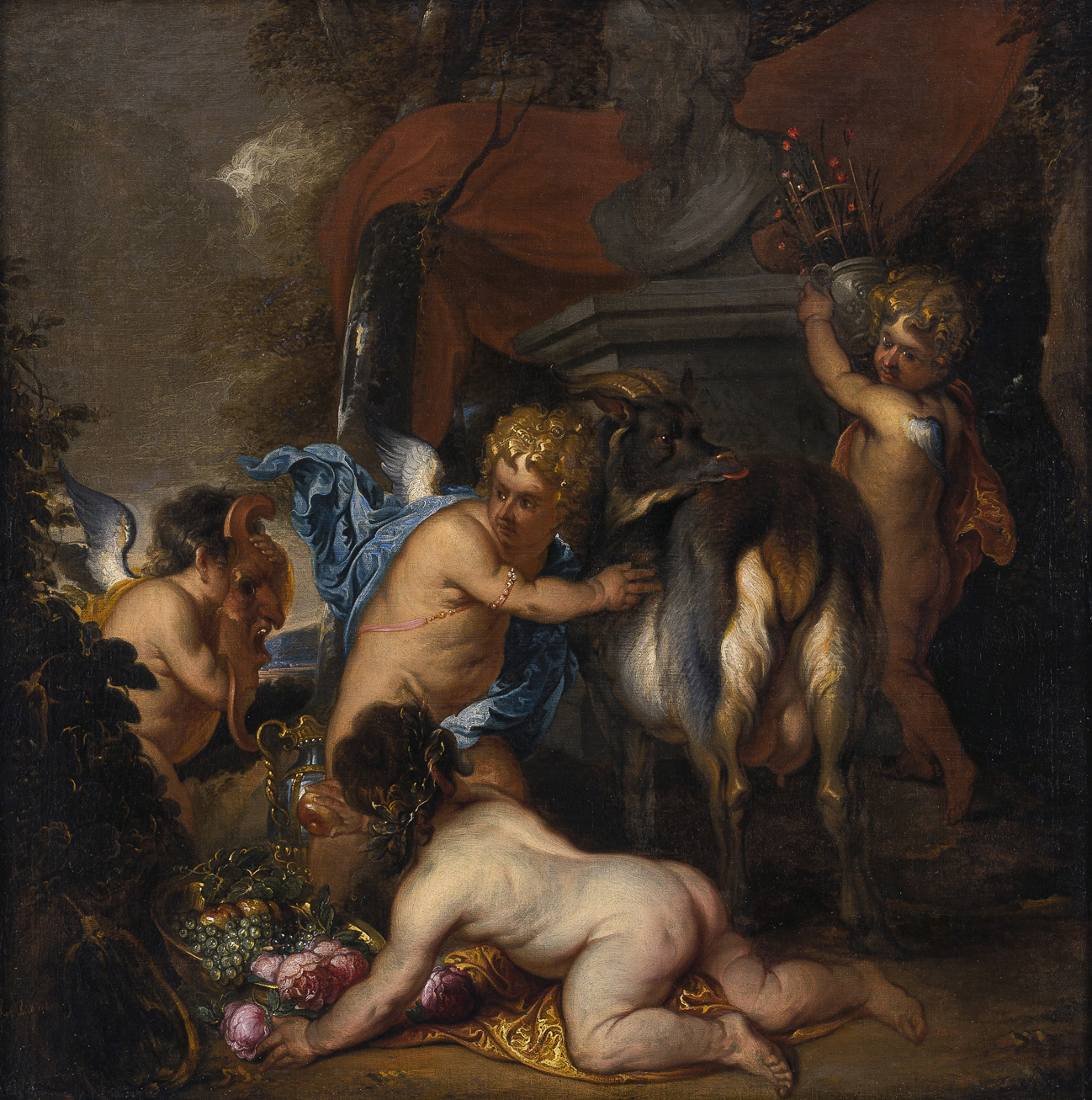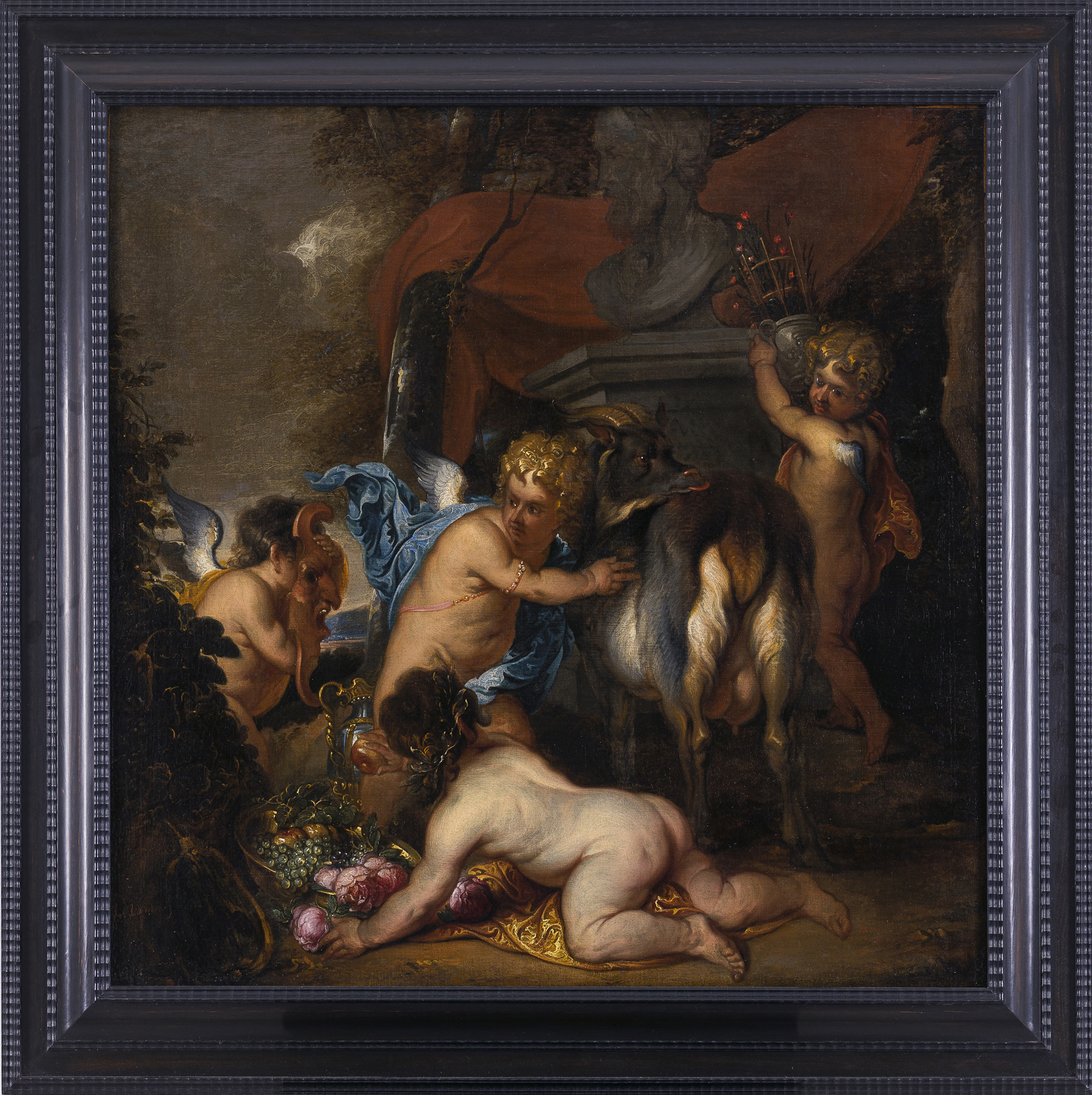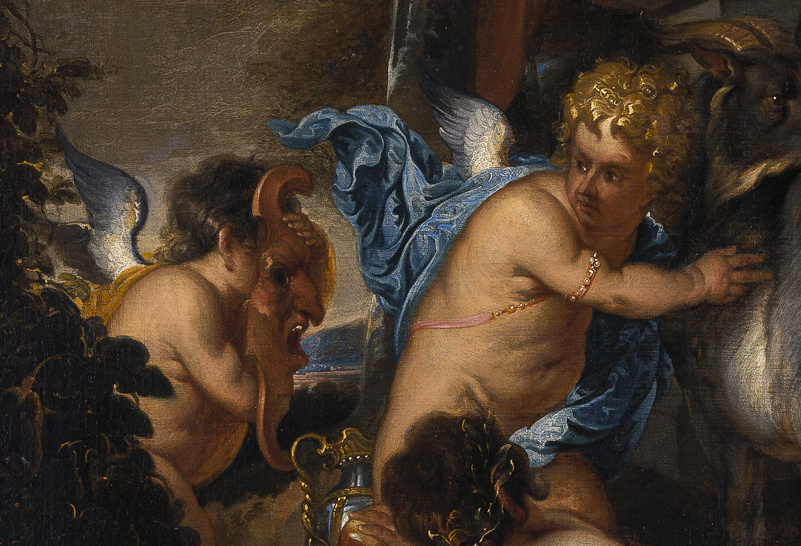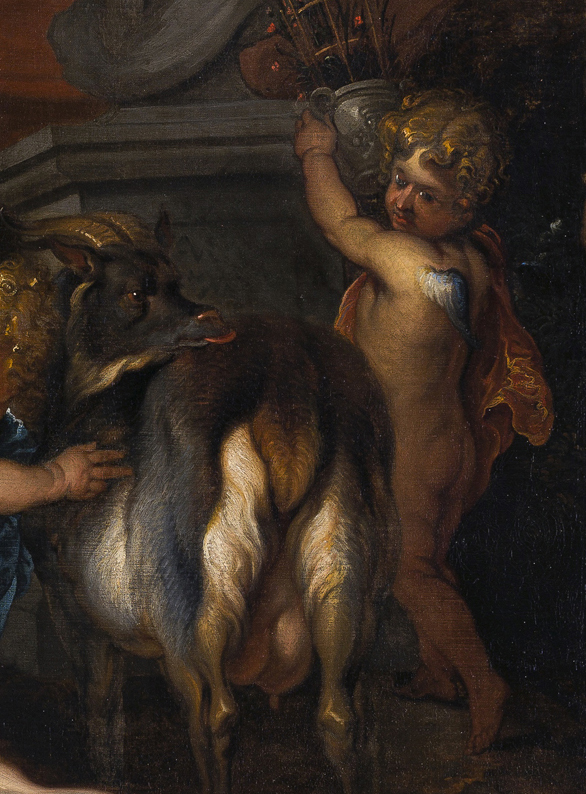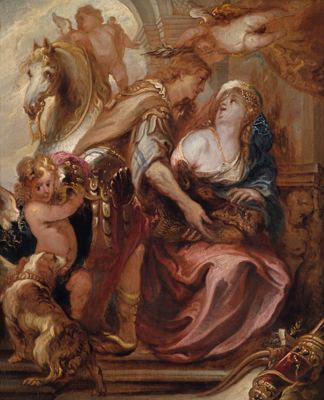PIETER CRIJNSE VOLMARIJN (Rotterdam c.1629 – 1679 Rotterdam)
Pieter Crijnse Volmarijn (Rotterdam c.1629 – 1679 Rotterdam)
Putti Cavorting with a Goat
Oil on canvas, 86 x 85 cm (33.9 x 33.5 inch); presented in an ebonised ripple frame of 17th-century model
Signed lower left ‘P Volmarijn’
Provenance
~ Anonymous auction Brussels (Giroux), 4 February 1930, lot 88: 'Pieter Volmaryn. Scène mythologique. Signé à gauche en bas. Toile. 85 x 85 cent.', repr.
~ Anonymous auction Brussels (Galerie Fievez), 13/14 May 1938, lot 127: 'P. Volmaryn, Angelots, amour et chèvre dans un paysage. Signé à gauche. Toile. H. 0,80; L. 0,80.'
~ Private collection, Belgium
Literature
~ S.J. Gudlaugsson, ‘Crijn Hendricksz Volmarijn, een Rotterdamse Caravaggist’, Oud-Holand, LXVII, 1952, pp. 244-245, 247
~ R.A. d'Hulst, ‘Pieter Crijnse Volmarijn, een Rotterdamse navolger van de Antwerpse schilderschool uit de 17de eeuw’, Mededelingen van de Koninklijke vlaamse Academie voor Wetenschappen, Letteren en Schone Kunsten van België, XXXII, 1970, pp. 14-15, repr. fig. 10
***
This recently rediscovered painting is the chef d’oeuvre of the rare Rotterdam painter Pieter Crijnse Volmarijn.1 Pieter was the son of Crijn Hendricksz Volmarijn (c.1601–1645), a painter of Caravaggesque historical paintings.2 Pieter is likely to have been initially instructed in the art of painting by his own father, who sadly died young; he was certainly taught by Hendrik Maertensz Sorgh, his uncle, as is recorded by contemporary sources.3 Though Sorgh primarily painted peasant interiors in the tradition of Teniers and Brouwer, this influence is not noticeable in Volmarijn’s presently known oeuvre, which is greatly inspired by the works of Rubens and his circle, especially Jordaens.
Crijn Hendricksz Volmarijn was active as an art dealer in addition to his own creative pursuits, and is mentioned in contemporary sources as a ‘schilderievercooper’. When Pieter’s mother Tryntge died in 1646, an inventory of the family’s worldly possessions was drawn up in 1648 by the ‘Weeskamer’ or orphans’ institution: here, in addition to easels, painting materials and limb figures, an extensive collection of more than three hundred paintings is listed, including works by Balthasar van der Ast, Isaac van Ostade, Salomon van Ruysdael, Pieter Mulier, Abraham van Beijeren, Frans Hals, Willem Buytewech and ‘twee troonties van Rembrandt’ (‘two head studies by Rembrandt’); however, it also mentions both original works and copies by Pieter, who would have executed these in his juvenile years.4
In the register of painters drawn up by the Amsterdam town doctor Jan Sysmus between 1669 and 1678, Pieter was described as a ‘discipel van Jordaens and Braber (Bramer)’. Although Volmarijn was still alive when Sysmus was compiling his information, we do not know if he did indeed study with the great Antwerp painter Jacob Jordaens (1593–1678), although his extant works are extremely inspired by this artist, especially the recently rediscovered painting. Pieter’s parents owned both original works by Jordaens and copies after this master, as is known from the 1648 inventory, so he would have been aware of the works of the Flemish master from an early age. Whether Volmarijn actually studied in Antwerp or only knew Jordaens's paintings, he was greatly influenced by him.
Works by Pieter Volmarijn are excessively rare, only a dozen or so are known today. For decades, the present painting, recently rediscovered by White Rose Fine Art, was the only known work by the artist, since its appearance in an auction in Brussels in 1930, when it was photographed and the signature was recorded.5 When the oeuvre of Pieter Volmarijn was first reconstructed by the Flemish art historian Roger d’Hulst in 1970, the present typical and signed painting was still a key work in the reconstruction.6
The painterly handling in our well preserved painting can be compared to a small-skale modello of Meleager Handing Atalanta the Head of the Calydonian Boar by the artist, which was formerly in the colletion of the art historian Dr Julius S. Held (fig.).7 Volmarijn was also active as a draughtsman: an elaborate and large drawing of Paulus and Barnabus in Lystra is preserved in the Royal Library of Belgium in Brussels.8 Although several works by Volmarijn are known from appearances on the art market, very few or indeed possibly none of his paintings are part of museum collections, due to their excessive rarity.
The precise subject of the present work remains somewhat of a mystery: dominated by a Classical bust on a pedestal, four putti are playing with a goat, a bowl of fruit and flowers, a vase of flowers and a grotesque mask. Professor d’Hulst speculated in 1970 that the scene had connections with the cult of Bacchus, and the goat might represent Amalthea, foster-mother of Zeus. It can be compared to the goat in The Infancy of Zeus, painted by Jordaens during the early 1630s (Louvre, Paris).9
SOLD
1. For Volmarijn, see R.A. d'Hulst, ‘Pieter Crijnse Volmarijn, een Rotterdamse navolger van de Antwerpse schilderschool uit de 17de eeuw’, Mededelingen van de Koninklijke vlaamse Academie voor Wetenschappen, Letteren en Schone Kunsten van België, XXXII, 1970, pp. 1-22 and N. Schadee (ed.), Rotterdamse Meesters uit de Gouden Eeuw, exh. cat. Rotterdam (Historisch Museum) 1994, p. 307.
2. For Crijn Hendricksz Volmarijn, see S.J. Gudlaugsson, ‘Crijn Hendricksz Volmarijn, een Rotterdamse Caravaggist’, Oud-Holand, LXVII, 1952, pp. 244-247; his Supper at Emmaus (panel, 144.5 x 121.5 cm, signed and dated ‘C.H. volmarin Ao 1631’ is preserved in the Rotterdam Museum, inv. no. HMR 64457; Schadee, op. cit., cat. no. 68.
3. “Voor leer ende kostgeld van Pieter”, P. Haverkorn van Rijsewijk, ‘Rotterdamse schilders. De schilders Volmarijn’, Oud-Holland, XII, 1894, pp. 154-55.
4. Abraham Bredius, ‘Das Nachlass-Inventar der Witwe von Crijn Hendricksz Volmarijn’, Quellenstudien zur Holländische Kunstgeschichte, The Hague 1918, XI, vol. V, pp. 1637–1644.
5. Gudlaugsson, op. cit., pp. 244-45: ‘Hoewel uit de archivalische bronnen alleen blijkt, dat Pieter Crijnse Volmarijn het eerste onderwijs in de schilderkunst bij zijn oom Hendrik Maertensz Sorgh te Rotterdam ontving (…), toont het enige heden ten dage van hem bekende werk (Putti met een geit) (…), dat hij inderdaad in sterke mate de invloed van Jordaens heeft ondergaan’.
6. d’Hulst, op. cit., pp. 14-15.
7. Oil on panel, 38.7 x 31.8 cm; formerly collection of Dr Julius S. Held, until Christie’s, New York, 27 January 2009, lot 31, repr.; d'Hulst, op. cit., p. 1, cat. no. 1.
8. Pen and brown ink, brown wash, gouache, 657 x 535 mm; inv. no. F7658; Daan van Heesch, Sarah van Ooteghem and Joris van Grieken (eds.), Bruegel and beyond: Netherlandish drawings in the Royal Library of Belgium 1500-1800, Antwerp 2022, p. 73, repr.
9. Oil on canvas, 150 x 203 cm, Musée du Louvre, inv. no. 1405; R.A. d’Hulst, N. de Poorter, M. Vandenven and H. Devisscher (eds.), Jacob Jordaens (1593 – 1678), exh. cat. Antwerp (Koninklijk Museum voor Schone Kunsten) 1993, cat. no. A45.
